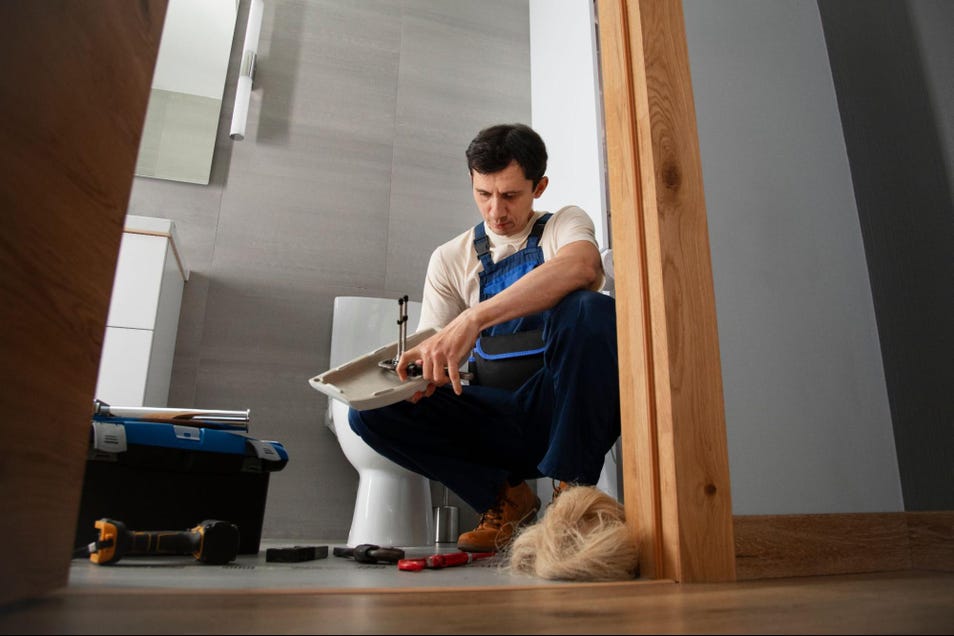Top Bathroom Maintenance Problems & Their Solution

An average person spends more than 182 hours per year in the bathroom, and many spend much more than the average.
With this much time spent in the bathroom, it is only natural that an out-of-commission bathroom would create an awkward inconvenience.
Whether commercial or residential, these bathroom problems are beyond merely annoying and can severely affect your water bills and sometimes cause property damage.
Hence, immediately addressing such bathroom maintenance problems using the right procedure and tools is imperative to ensure complete bathroom safety and transform them into a wellness oasis.
1. Clogged toilets
A clogged toilet occurs when some solid waste or foreign objects prevent the water from flowing through the pipes, causing the water to rise back up and not drain properly from the toilet bowl.
Some of the most common reasons for a toilet to clog include inadequate flushing strength, obstructed trap or drainpipe, or accumulation of non flushable materials like toilet paper, sanitary products, etc.
Solution: Submerge the head of the plunger into the toilet bowl and place it over the hole. Plunge up and down rapidly, keeping the plunger under the water level, and lift it only an inch or so on every upstroke.
Additionally, avoid flushing non-flushable items, dispose of water properly, or consult a professional plumber to prevent future blockage occurrences.
2. Clogged drains
Clogged drains occur when dirt, dust, grease, limescale, hair, soap scum, toothpaste, or other debris obstruct the flow of the water through household drains, leading to slow drainage or complete blockage.
Solution: To prevent drain clogging, install drain covers or traps to catch hair and other potential debris, and clean the drain regularly using hot water and a drain cleaner.
Additionally, grease and limescale buildup contribute largely to drain blocking, so make sure to clean your sink with Harpic Bathroom Cleaner. This product not only removes limescale, grease, and rust but also eliminates 99.9% of germs and bacteria for a hygienic environment.
3. Silent leaks
Silent leaks in bathrooms occur when water escapes from pipes, fixtures, or equipment unnoticed, often behind walls, under floors, or from the tank into the bowl. These leaks lead to wasted water, a hike in the water bill, and structural damage.
Solution: Regularly inspect plumbing fixtures throughout the bathroom for any signs of leaks and replace worn-out parts. Moreover, you can also install leak detection devices and consider upgrading to water-efficient fixtures to minimize water usage and the risk of leaks.
4. Limescale
Limescale, an unsightly chalky white deposit, forms on bathroom surfaces like faucets, showerheads, tiles, and inside toilet bowls due to minerals like calcium and magnesium accumulation after hard water evaporates.
Limescale can build up to the point where it starts interfering with the functioning of the fixtures, clogging faucets, showerheads, and toilet bowls, reducing water flow, damaging the plumbing systems, and diminishing the bathroom’s aesthetic.
Solution: To dissolve limescale deposits and prevent them from occurring again, install a water softener to reduce the mineral content from the hard water.
Regularly clean your toilet bowl with Harpic PowerPlus Original and other bathroom surfaces with Harpic Bathroom Cleaner.
5. Broken toilet handles
The toilet tank handle breaks when the flushing mechanism malfunctions or becomes damaged. It is important to fix this problem as soon as it is identified.
Some common causes include wear and tear over time, excessive force applied to the handle, or corrosion due to exposure to moisture.
Solution: Gently handle the toilet handles during use and avoid using too much force or pressure. Moreover, regularly inspect for signs of wear and tear and promptly replace any worn-out handle with durable replacements to ensure smooth and continuous flushing operations.
FAQ
What happens to a toilet if not used for a long time?
If a toilet is not used for a long time, the water in the toilet bowl will dry up, allowing the sewer gas and critters into your house. Additionally, the water in the tank would evaporate, eventually leading to the float drop, allowing the tank to refill and the whole cycle to repeat itself.
How often should I deep clean my bathroom?
The bathroom cleaning frequency may vary depending on the household usage, number of occupants, and personal preferences. However, you should deep clean your bathroom at least once a week to maintain cleanliness and prevent the buildup of dirt, dust, grime, limescale, germs, and bacteria.
How do you maintain an unused toilet?
Just like unused cars, you must keep the unused toilet running periodically so they don’t stop working. For the toilet, you need to flush them at least once a week.
.png?width=70&height=88&format=png&quality=50)